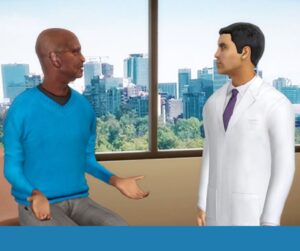Jenny Veliz-Urzua, DNP, MSN, FNP-BC
As health care burnout is related to increased suicidal ideation1 and data demonstrating that health care workers are at increased risk for suicide,2 it would behoove us to focus on measures to prevent burnout. That is usually easier said than done, especially when oncology health care workers deal with a significant amount of emotional exhaustion.3 On an organizational level, many institutions have developed well-being courses. It is important for health care providers to develop skills that will help prevent repeated entrance into states of burnout and emotional exhaustion.
Abraham M. Gutsioglou, PhD, is an author, speaker, educator, business strategist, and futurist with a passion for transformations and helping people to think differently about themselves and the world around them. In this interview, conducted by Jenny Veliz-Urzua, DNP, MSN, FNP-BC, a surgical oncology nurse practitioner at Stanford Health Care and a member of The Oncology Connection Editorial Advisory Board, he discusses how oncology-based advanced practice providers (APPs) can leverage his expertise into actionable behavioral changes that prevent burnout and emotional exhaustion.

What is an enabling behavior pattern that sets up health care providers in an environment where we allow worsening effects of emotional exhaustion?
An enabling behavior pattern that contributes to emotional exhaustion is a sense of never-ending responsibility without clear boundaries. Health care providers often enter the profession with a genuine passion and drive to help others. However, this very same passion can lead to excessive workload and an inability to switch off from work. Over time, this will drain all well-being; it will then serve as fuel for emotional, physical, and psychological exhaustion. The more a person engages in this behavior, the quicker it leads to the creation of unsustainable patterns with unrealistic expectations, making it extremely difficult to say no to additional responsibilities, ultimately creating a destructive cycle.
As a way to address this, it is critically important to define and live by clear boundaries with yourself and others. Start by recognizing the limits of what you can reasonably achieve and learning to say no when you begin to reach your capacity. Self-awareness is huge here! Keep in mind that this also means setting aside designated times to take care of yourself. Create intentional moments where you can rest and rejuvenate. Keep things simple. For example, when you are home after work, instead of scrolling through social media, listen to music that calms you down. If you have a dog, go on a 5-minute walk. When you take a shower, be present, take a deep breath and focus on the water.
The key is that you intentionally integrate small things that allow time for recovery. See it this way. If you are not in the right headspace, your emotional battery is drained, and your body will slowly break down. This will make it nearly impossible to care for others. To be the best for others, you must feel at your best and that starts by focusing on yourself.
What daily actionable change can health care providers make to set up for successful changes?
Start with time management strategies. In the demanding and fast-paced world of health care, managing time efficiently is paramount for preventing burnout. Health care providers often find themselves facing a never-ending stream of tasks, and without proper time management, it can become overwhelming. Try prioritizing tasks by identifying the most critical and time-sensitive responsibilities and allocating time and resources accordingly. Set realistic goals and expectations for the day; this will help to better manage workload and reduce stress throughout the day.
Think of it as creating a structured workday that includes short breaks for relaxation, even in the busiest schedules. These brief moments will provide the mental and emotional space needed to recharge, recalibrate, and mitigate the risk of emotional exhaustion. Over time, these actions will set the stage for more successful changes and will lead to significant improvements in well-being. Trust the process.
We know physical exhaustion is also a contributing factor to burnout. As health care providers, we are low on time as it is. What is your advice on the minimal input we should do and its effect on emotional state?
Physical exhaustion is undeniably a contributing factor to burnout, but I understand that health care providers face significant time constraints. In the world of health care, where every minute counts, it can be challenging to find the time for extensive physical activity. However, even minimal physical activity can have a substantial impact on emotional wellbeing. As little as 5 to 10 minutes a day can make a significant difference.
- For some people, tiny bursts of physical activity—like intentional power walks to and from meetings (or getting to the car, train, etc.)—have the power to release endorphins, reduce stress, and improve overall mood.
- High-intensity interval training, or HIIT, for example, involves short, intense bursts of exercise followed by brief rest periods. It is known for its efficiency in boosting both physical and emotional well-being.
- Additionally, mindfulness-based exercises, such as deep breathing or quick meditation sessions, can be seamlessly integrated into short breaks during the workday.
These exercises are particularly useful for reducing stress and enhancing emotional resilience. It’s important to remember that it’s not about the duration of physical activity but the consistency. By incorporating these short activities into daily routines, health care providers can significantly alleviate physical and emotional exhaustion, ultimately contributing to improved overall well-being.
If this still feels like too much, then flip your mental script. Let’s say that a patient came to you with this problem and asked for your advice on what simple things they can do to improve their well-being. When you come up with that list, all you have to do is follow your own advice.
Can you elaborate more on what “transformation” means to you and how it connects to human performance and overall well-being, especially for health care providers?
Transformation, in the context of human performance and overall well-being, represents a profound shift in mindset and behavior, allowing individuals to reach their highest levels of performance while maintaining their emotional equilibrium. This transformation is not a mere change; it’s a fundamental re-evaluation of one’s beliefs, thought patterns, and daily practices.
For health care providers, transformation entails viewing their roles through a new lens. It’s about understanding that their own well-being is not a luxury but a necessity, not just for their sake but for the quality of care they provide to patients. Transformation empowers health care providers to “think differently” about their work and its impact on their lives and the world around them. At its core, transformation is a process that encourages people (especially health care providers) to prioritize self-care, establish clear boundaries, and make sustainable changes. It involves embracing self-compassion and recognizing that their own well-being is intertwined with their ability to provide excellent care. When health care providers adopt a transformative mindset, they become more resilient, both emotionally and physically.
Transformation also involves setting aside time for reflection and self-awareness. Health care providers can take moments each day to evaluate their well-being and assess their stress levels. By recognizing early signs of burnout or emotional exhaustion, they can proactively address these issues before they become overwhelmed.
This transformative approach extends to the workplace as well. It encourages health care providers to communicate openly with their colleagues and superiors about their well-being, fostering a supportive and understanding environment. Transformation is not just an individual journey; it can ripple through the entire health care team, creating a culture of well-being where care is also something done for each other, not just the patients.
If I can leave you with a single thought, let it be this: Transformation is not a one-time event but an ongoing process. It is the daily commitment to aligning one’s values, beliefs, and actions in a way that promotes exceptional performance and personal well-being. It’s about fostering a sense of balance and harmony between the demands of the health care profession and the need for self-care. Ultimately, this transformation paves the way for health care providers to excel in their roles while maintaining their own emotional and physical health, resulting in a positive impact on both their professional and personal lives.

References
- Fisher, L. (2022). Nurses consider suicide more than other US workers. Oncology Nursing News. https://www.oncnursingnews.com/view/nurses-consider-suicide-more-than-other-us-workers
- Olfson, M., Cosgrove, C.M., Wall, M.M., & Blanco, C. (2023). Suicide Risks of Health Care Workers in the US. JAMA, 330(12), 1161–1166.
- Hlubocky, F. J., Back, A. L., & Shanafelt, T. D. (2016). Addressing Burnout in Oncology: Why Cancer Care Clinicians Are At Risk, What Individuals Can Do, and How Organizations Can Respond. American Society of Clinical Oncology educational book. American Society of Clinical Oncology. Annual Meeting, 35, 271–279.






